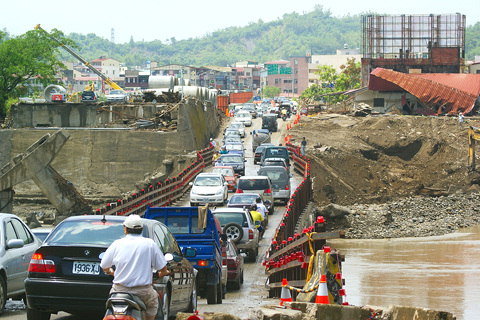Transportation experts have suggested that the government factor in climate change and reconsider construction methods used for transportation infrastructure when repairing or rebuilding highways and bridges devastated by Typhoon Morakot.
Professor Jason Chang (張學孔) of the civil engineering department at National Taiwan University said the Ministry of Transportation and Communications (MOTC) should raise construction standards for highways and bridges to counter challenges brought on by climate change.
“Many of the nation’s transportation facilities were built with the premise that big floods will only occur once every 100 years or 200 years,” Chang said. “But given the changing rainfall patterns nowadays, we might have to change that premise by shortening the presumed frequency to perhaps once every 50 years.”

PHOTO: HUANG CHIA-LIN, TAIPEI TIME
“Each transportation facility must be built with a stronger structure to withstand such floods,” he said.
Aside from challenges brought by extreme weather conditions, Chang said that the methods used to construct highways or bridges would also have to change.
“In the past, we liked to straighten supposedly meandering routes to reduce travel time for people,” Chang said. “So if we could use any method to shorten the route, we just went ahead and did it.”
“After the damage suffered this time, we should start building bridges or roads by yielding to the form of natural terrain as much as possible,” Chang said.
>
“This means that it might take longer to build. But there is always a tradeoff. Do we want something that was built fast and is potentially unsafe, or do we sacrifice expediency to build something that can coexist with nature and last longer?” he asked.
When rebuilding damaged infrastructure in new locations, the MOTC will have to be very careful in choosing the sites and avoid geologically sensitive zones, Chang said.
“The problem has already occurred when they constructed the Hsuehshan Tunnel, with the route they chose passing through several water veins in northern regions,” Chang said.
Professor Wang Jung-yue (王仲宇) of National Central University is one of a number of consultants recruited by the Public Construction Commission (PCC) to draw up a set of guidelines for rebuilding damaged bridges. Wang also stressed the importance of climate change.
“Any bridge reconstruction that fails to take into account climate change would only be a waste of money and labor,” Wang said.
Earlier this year, the Directorate General of Highways (DGH) completed a comprehensive inspection on bridges of provincial and county highways nationwide and listed 50 bridges that need to be repaired.
The directorate’s general secretary Mile Chen (陳茂南) said the DGH had to not only conduct a new nationwide inspection of bridges, but also had to review the conditions previously set for closing the bridges.
“We have learned something this time from the Shuangyuan Bridge (雙園大橋), which collapsed before the water in the river rose to the height that had been deemed dangerous enough to shut down the bridge,” Chen said.
Chen said the bridge is located at the mouth of a river, which makes it difficult to gauge the real water level because of tidal differences.
“We cannot use the water level as the only indicator to decide if we should close the bridge anymore,” Chen said. “When we set the standards, we also need to consider other factors, such as the speed of the river flow, the characteristics of the river basin and the extent to which the water scours the bridge piers.”
Meanwhile, Chen said, there was a need to set up an alarm system that monitors changes in water level upstream during stormy weather.
The engineers at the DGH also have to be trained to interpret various data provided by the Water Resources Agency to make better judgments on how it could take proactive action to protect bridges.
The MOTC has estimated that it needs a total of approximately NT$31 billion (US$942 million) to repair damaged facilities under its administration. Among them, about NT$29 billion will be appropriated to the DGH to restore devastated highways.
The Central Weather Bureau has identified the towns in southern Taiwan that received the highest accumulated rainfall when the nation was hit by Morakot between Aug. 7 and Aug. 10: Dapu (大埔), Alishan (阿里山) and Juci (竹崎) in Chiayi, Liouguei (六龜), Jiasian (甲仙) and Taoyuan (桃源) in Kaohsiung and Sandimen (三地門) in Pingtung.
These towns received an average of 74 percent of their usual annual rainfall during the three days.
Liouguei, Jiasian and Juci were also on the nation’s top 10 accumulated rainfall list when Tropical Storm Kalmaegi hit last year.
Liu Chung-ming (柳中明), director of the Global Change Research Center at National Taiwan University, said the nation had to get used to extreme weather.
“We just had the highest temperature ever recorded, 39.5˚C, in Hsinchu the week before Morakot came,” Liu said. “The next thing you know we receive the heaviest rainfall so far this year.”
Liu said that between 1960 and 2000, an average of 30 typhoons and tropical storms formed in the Northwest Pacific Ocean per year. Between 2000 and last year, the number dropped to an average of 24 per year.
Before 2000, only about 4.5 typhoons would actually affect Taiwan, but from 2000 to last year, an average of 7.1 typhoons hit the nation each year.
So far, three typhoons have made landfall this year and only nine tropical storms and typhoons have formed in the Northwest Pacific Ocean.

‘DENIAL DEFENSE’: The US would increase its military presence with uncrewed ships, and submarines, while boosting defense in the Indo-Pacific, a Pete Hegseth memo said The US is reorienting its military strategy to focus primarily on deterring a potential Chinese invasion of Taiwan, a memo signed by US Secretary of Defense Pete Hegseth showed. The memo also called on Taiwan to increase its defense spending. The document, known as the “Interim National Defense Strategic Guidance,” was distributed this month and detailed the national defense plans of US President Donald Trump’s administration, an article in the Washington Post said on Saturday. It outlines how the US can prepare for a potential war with China and defend itself from threats in the “near abroad,” including Greenland and the Panama

A wild live dugong was found in Taiwan for the first time in 88 years, after it was accidentally caught by a fisher’s net on Tuesday in Yilan County’s Fenniaolin (粉鳥林). This is the first sighting of the species in Taiwan since 1937, having already been considered “extinct” in the country and considered as “vulnerable” by the International Union for Conservation of Nature. A fisher surnamed Chen (陳) went to Fenniaolin to collect the fish in his netting, but instead caught a 3m long, 500kg dugong. The fisher released the animal back into the wild, not realizing it was an endangered species at

The Chinese Nationalist Party (KMT) is maintaining close ties with Beijing, the Democratic Progressive Party (DPP) said yesterday, hours after a new round of Chinese military drills in the Taiwan Strait began. Political parties in a democracy have a responsibility to be loyal to the nation and defend its sovereignty, DPP spokesman Justin Wu (吳崢) told a news conference in Taipei. His comments came hours after Beijing announced via Chinese state media that the Chinese People’s Liberation Army’s Eastern Theater Command was holding large-scale drills simulating a multi-pronged attack on Taiwan. Contrary to the KMT’s claims that it is staunchly anti-communist, KMT Deputy

The High Prosecutors’ Office yesterday withdrew an appeal against the acquittal of a former bank manager 22 years after his death, marking Taiwan’s first instance of prosecutors rendering posthumous justice to a wrongfully convicted defendant. Chu Ching-en (諸慶恩) — formerly a manager at the Taipei branch of BNP Paribas — was in 1999 accused by Weng Mao-chung (翁茂鍾), then-president of Chia Her Industrial Co, of forging a request for a fixed deposit of US$10 million by I-Hwa Industrial Co, a subsidiary of Chia Her, which was used as collateral. Chu was ruled not guilty in the first trial, but was found guilty